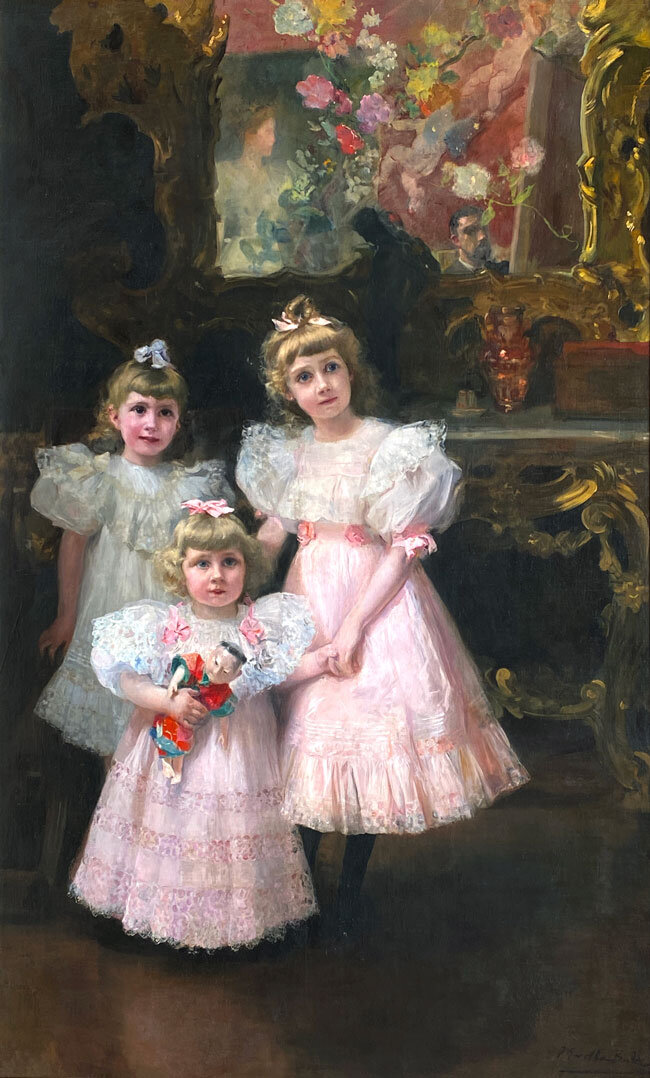JOAQUÍN SOROLLA Y BASTIDA PAINTINGS FOR SALE & BIOGRAPHY
JOAQUÍN SOROLLA Y BASTIDA
Spanish, 1863-1923
BIOGRAPHY
'Joaquín Sorolla y Bastida studied at the Escuela de Bellas Artes in Valencia and in the studio of Gonzalo Salva. He was influenced by the two Valencian painters Bernardo Ferrandiz and Francisco Domingo Marqués, but by far his strongest influence was Ignacio Pinazo Camarlench, as can be seen in Sorolla's work prior to 1885. He obtained a travel scholarship to Italy, and worked in Rome and Assisi from 1884 to 1888, where he received advice from Francisco Pradilla y Ortiz. He settled in Madrid, travelling regularly to France and visiting Paris frequently in order to study the work of the Paris School with whom he felt an affinity. He married Clotilde García del Castillo in Spain. He became paralysed in one side of his body and gave up painting in June 1920.
At the age of 20, Sorolla caught the art world's attention with the realism of his 2 May 1808, in which the three aspects which were to characterise his work thereafter are apparent: a constant preoccupation with light, painting in the open air (to which he was introduced by Gonzalo Salva) and the quiet development of controlled drawing. He painted a wide range of subjects, from historical compositions such as The Death of Valentino to religious paintings such as: The Burial of Christ(now destroyed); St Claire; The Kissing of the Relic; St Sebastian; portraits: Elena; Mother; Clerk of the Court; Doctor Simarro in His Laboratory; Alfonso XIII in Hussar's Uniform; genre scenes: Sewing Sails; Return from Fishing; Bathing; View of Spain; Valencia; and landscapes: Sea and Rocks at San Esteban; The Asturias; Toledo.
In 1911, Sorolla received a commission for a series of decorative panels illustrating The Provinces of Spain, for the library of the Hispanic Society of America in New York, a monumental work 190 feet (58 metres) wide, on which he worked for nearly six years. From 1917 to 1918, the themes of the countryside and the beach, which had been close to the artist's heart, made way for the garden. Sorolla completed several different versions of the gardens of the Alcázar in Seville and the Alhambra in Granada.
From observation of his native Valencia, Sorolla learned to render, and use for other ends, the hazy dust of the light and the vivid colours produced by the shadows. His passion for translating nature and light onto the canvas just as he saw it allied him firmly with the Impressionists. Sorolla's own success at home ensured the success of the other Impressionists in Spain and heralded the fall from grace of traditional studio painting. His technique is in many ways similar to that of his friend Zorn. He was particularly skilled in transposing the effect of light on water, the transparency of water on sand and the dazzling streams of light flowing over the naked bodies of bathers in the open air.
Sorolla featured in various collective exhibitions including: Salón Nacional de la Sociedad Nacional de Bellas Artes, Madrid (from 1881 obtaining medals in 1892, 1884 for 2 May 1808 and 1895) and Munich, Vienna, Venice, Rome and Chicago. As a correspondent member of the Société des Artistes Français in Paris, he played an active part in the Salon exhibitions. He obtained a second-class medal in 1890 with Parisian Boulevard, a third-class medal in 1893, a second-class medal in 1895 and the Grand Prix in 1900, for the Exposition Universelle. He also showed work in solo exhibitions, including: Georges Petit Gallery, Paris (1906); Berlin, Düsseldorf and Cologne (1907); Grafton Galleries, London (1908); New York, Buffalo and Boston (1909); the Art Institute, Chicago; the City of Art, St Louis (1911). He was made a Chevalier of the Légion d'Honneur in 1900. (Benezit, Dictionary of Artists, Paris, 2006)
Museum Collections
Art Institute of Chicago, Chicago, IL
Cincinnati Art Museum, Cincinnati, OH
Clark Art Institute, Williamstown, MA
Galleria Nazionale d’Arte Moderna, Rome
Galleria d’Arte Moderna, Udine
Harvard University Art Museums, Cambridge, MA
Hispanic Society of America, New York, NY
The J. Paul Getty Museum, Los Angeles, CA
Meadows Museum, SMU, Dallas, TX
Metropolitan Museum of Art, New York, NY
Musée d’Orsay, Paris
Musée des Beaux-Arts, Burdeos
Museo de Arte de Ponce, Ponce, Puerto Rico
Museo de Bellas Artes de Bilbao, Vizcaya
Museo de Bellas Artes de Valencia, Valencia
Museo de Bellas Artes, Seville
Museo de Zaragoza, Zaragoza
Museo Nacional de Bellas Artes, Buenos Aires
Museo Nacional del Prado, Madrid
Museo Nacional de San Carlos, Conaculta, Mexico
Museo Sorolla, Madrid
Museu d’Art Modern, Barcelona
Museum of Fine Arts, Boston, MA
Philadelphia Museum of Art, Philadelphia, PA
Rhode Island School of Design, Providence, RI
San Diego Museum of Art, San Diego, CA
Smith College Museum of Art, Northampton, MA
Mark Murray Fine Paintings is a New York gallery specializing in buying and selling 19th century and early 20th century artwork.
JOAQUÍN SOROLLA Y BASTIDA
Paintings for sale
Currently there are no available Joaquín Sorolla y Bastida paintings for sale at the Mark Murray Gallery.
Please contact us if you are interested in selling your Joaquín Sorolla y Bastida paintings or other artwork from the 19th century and early 20th century.
Joaquín Sorolla y Bastida Paintings Previously Sold
JOAQUÍN SOROLLA Y BASTIDA
The Daughters of Rafael Errázuriz
Oil on canvas
89½ x 54¾ inches (227.5 x 139 cm)
SOLD
JOAQUÍN SOROLLA Y BASTIDA
Portrait of a Jack Russell
Oil on canvas
18 x 18 inches (45.7 x 45.7 cm.)
SOLD
JOAQUÍN SOROLLA Y BASTIDA
Cabeza de un Viejo Pescador (c.1897)
Oil on canvas
17 x 19¾ inches (43 x 50 cm)
SOLD




